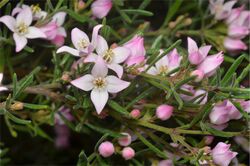Biology:Boronia hippopala
| Velvet boronia | |
|---|---|

| |
| Boronia hippopala in the Royal Tasmanian Botanical Gardens | |
| Scientific classification | |
| Kingdom: | Plantae |
| Clade: | Tracheophytes |
| Clade: | Angiosperms |
| Clade: | Eudicots |
| Clade: | Rosids |
| Order: | Sapindales |
| Family: | Rutaceae |
| Genus: | Boronia |
| Species: | B. hippopala
|
| Binomial name | |
| Boronia hippopala Duretto[1]
| |

| |
| Occurrence data from Australasian Virtual Herbarium | |
Boronia hippopala, commonly known as velvet boronia[2] is a plant in the citrus family Rutaceae and is endemic to Tasmania. It is an erect, woody shrub with pinnate leaves and white to pink, four-petalled flowers.
Description
Boronia hippopala is an erect, woody shrub that grows to about 1.5 m (5 ft) high and its branches and leaves covered with minute hairs. The leaves have three, five or seven leaflets and are 6–10 mm (0.2–0.4 in) long and 6–14 mm (0.2–0.6 in) wide in outline on a petiole 2–3 mm (0.08–0.1 in) long. The end leaflet is linear to narrow elliptic, 1–4 mm (0.04–0.2 in) long and 1–2 mm (0.04–0.08 in) wide and the side leaflet are similar but longer. The flowers are white to pink and are arranged singly or in groups of up to three in upper leaf axils, the groups on a peduncle up to 1 mm (0.04 in) long. The four sepals are narrow triangular, 1–2 mm (0.04–0.08 in) long and 0.5–1 mm (0.02–0.04 in) wide. The four petals are 3.5–4.5 mm (0.1–0.2 in) long and the eight stamens are hairy. Flowering occurs from October to January and the fruit is a capsule about 2.5 mm (0.1 in) long and 1.5 mm (0.06 in) wide.[2][3][4][5]
Taxonomy and naming
Boronia hippopala was first formally described in 2003 by Marco F. Duretto who published the description in Muelleria from a specimen collected on Mount Arthur.[6][3] The specific epithet (hippopala) is said to be derived from the Latin words hippo meaning "horse" and palus meaning "marsh" referring to the usual habitat of this species.[3] Other sources give equus as the classical Latin word for "horse" and the ancient Greek hippos (ἵππος) for "horse".[7][8]
Distribution and habitat
The velvet boronia grows in wet heath or scrub. It is only known from three populations near St Pauls River in northern Tasmania.[2][4]
Conservation
Boronia hippopala is listed as "vulnerable" under the Commonwealth Government Environment Protection and Biodiversity Conservation Act 1999 (EPBC) Act and the Tasmanian Government Threatened Species Protection Act 1995.The main threats to the species are dieback caused by Phytophthora cinnamomi, inappropriate fire regimes and changes in water flow.[4]
References
- ↑ "Boronia hippopala". https://biodiversity.org.au/nsl/services/apc-format/display/181010. Retrieved 16 March 2020.
- ↑ 2.0 2.1 2.2 "Boronia hippopala". Tasmanian Government Department of Primary Industries, Parks, Water and Environment. https://dpipwe.tas.gov.au/Documents/Boronia%20hippopala%20listing%20statement.pdf. Retrieved 6 February 2019.
- ↑ 3.0 3.1 3.2 Duretto, Marco F. (2003). "Notes on Boronia (Rutaceae) in eastern and northern Australia". Muelleria 17: 84–87. https://www.rbg.vic.gov.au/documents/Muelleria_17,_p19-135,_Duretto,_Notes_on_Boronia.pdf. Retrieved 6 February 2019.
- ↑ 4.0 4.1 4.2 "Approved Conservation Advice for Boronia hippopala (Velvet Boronia)". Australian Government Department of the Environment. http://www.environment.gov.au/biodiversity/threatened/species/pubs/78925-conservation-advice.pdf. Retrieved 6 February 2019.
- ↑ "Boronia hippopala". Tasmanian Herbarium, Tasmanian Museum & Art Gallery. http://demo1.tmag.tas.gov.au/treatments/families/Rutaceae/Rutaceae.html. Retrieved 7 February 2019.
- ↑ "Boronia hippopala". APNI. https://id.biodiversity.org.au/instance/apni/586868. Retrieved 6 February 2019.
- ↑ Lewis, C.T. & Short, C. (1879). A Latin dictionary founded on Andrews' edition of Freund's Latin dictionary. Oxford: Clarendon Press.
- ↑ Liddell, H.G. & Scott, R. (1940). A Greek-English Lexicon. revised and augmented throughout by Sir Henry Stuart Jones. with the assistance of. Roderick McKenzie. Oxford: Clarendon Press.
Wikidata ☰ Q18082373 entry


